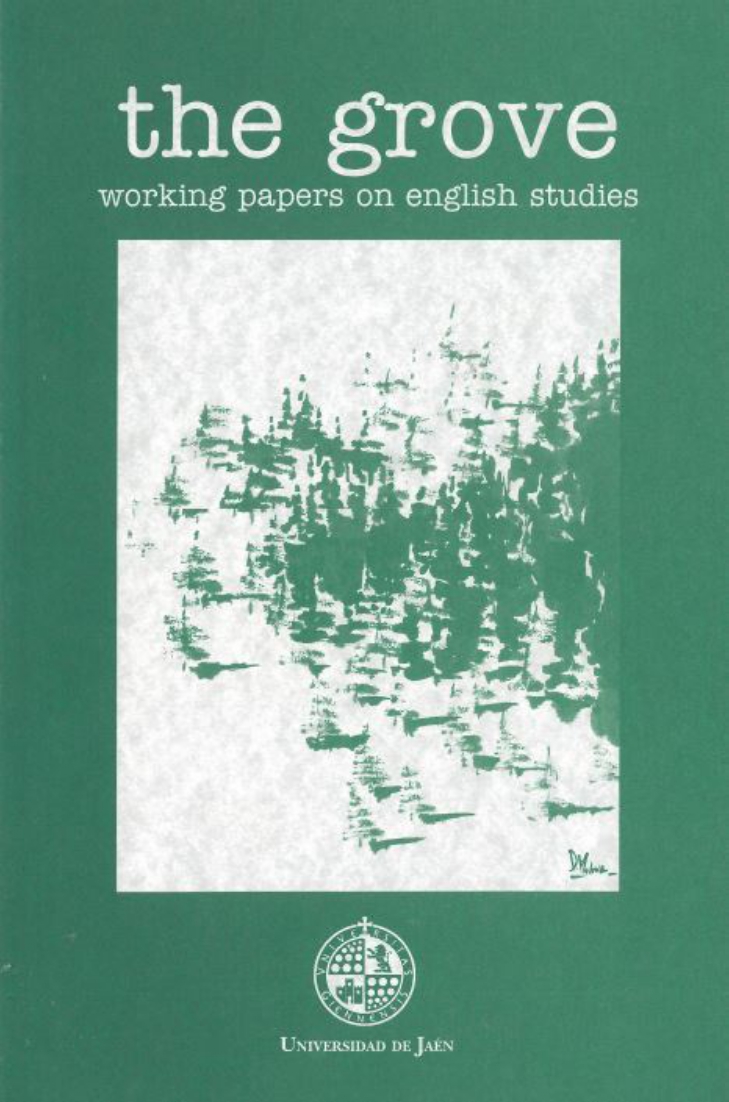Bodies that Speak
Traumatic Corporeal Spatiality in Doris Lessing's Novella "The Eye of God in Paradise"
DOI:
https://doi.org/10.17561/grove.v29.7237Keywords:
space, literature, body, war, traumaAbstract
The present article examines the treatment of spatial corporeality in Doris Lessing’s novella “The Eye of God in Paradise” (1957) set in Germany in the aftermath of the Second World War. Even though Lessing’s works have been studied from different perspectives—as the abundant critical studies show—, spatial corporeality has not been analysed before. This paper argues that the characters’ bodies, insofar as physical spaces of flesh and blood that are lived and where power is exerted, represent the trauma encountered by countless anonymous people who suffered due to the horrors of the war and who have only been made visible by the author’s skilled pen. By highlighting the corporeal spatiality in its physical, psychological, and sociohistorical division, Lessing has brought to the fore the intense suffering of unknown people, to give them identity as well as visibility and transform them into a locus of contesting power relations.
Downloads
References
Andermahr, Sonya and Silvia Pellicer-Ortin, eds. Trauma Narratives and Herstory. Palgrave Macmillan, 2013.
Argyle, Michael. Bodily Communication.1975. 2nd. ed. Routledge, 1988.
Becket, Fiona. “Environmental Fables? The Eco-politics of Doris Lessing’s ‘Ifrik’ Novels.” Doris Lessing. Border Crossings. Eds. Alice Ridout and Susan Watkins. Continuum International Publishing Group, 2009. 129-42.
Bessel, Richard, and Dirk Schumann, eds. Life after Death: Approaches to a Cultural and Social History of Europe During the 1940s and 1950s. Cambridge University Press. ProQuest EBook Central, 2003.
Bigot, Corinne. “Locking the Door: Self-Deception, Silence and Survival in Alice Munro’s ‘Vandals.” Trauma Narratives and Herstory. Eds. Sonya Andermahr and Silvia Pellicer-Ortin, 2013, pp. 113-28.
Brazil, Kevin, David Sergeant, and Tom Sperlinger, eds. Doris Lessing and the Forming of History.Edinburgh University Press, 2018.
Britannica, The Editors of Encyclopaedia. “Anomie.” Encyclopedia Britannica, 27 May 2020, https://www.britannica.com/topic/anomie. Accessed 23 Oct. 2022.
Caruth, Cathy. “Violence and Time: Traumatic Survivals.” Assemblage vol. 20, 1993, pp. 24-25.
Caruth, Cathy, ed. Trauma: Explorations in Memory. The Johns Hopkins University Press, 1995.
Di Prete, Laura. “Foreign Bodies”: Trauma, Corporeality, and Textuality in Contemporary American Culture, University of South Carolina, Ann Arbor, 2003. Proquest. https://www.proquest.com/dissertations-theses/foreign-bodies-trauma-corporeality-textuality/docview/305314255/se-2. Accessed 8 Nov. 2022.
Felman, Shoshana and Dori Laub, M. D. Testimony. Crises of Witnessing in Literature, Psychoanalysis, and History, Routledge, 1992.
Foucault, Michel. Power / Knowledge. Selected Interviews and Other Writings 1972-1977. Vintage Books, 1980.
Hall, Edward T. The Silent Language. 1959. Doubleday, 1981.
Hall, Edward T. The Hidden Dimension. 1966. Doubleday, 1982.
Hartman, Geoffrey. “Traumatic Knowledge and Literary Studies.” New Literary History, vol. 26, no.3, 1995, pp. 537-63. https://doi.org/10.1353/nlh.1995.0043
Herzog, Dagmar. Sexuality and German Fascism. Berghahn Books, 2005.
History. https://www.history.com/news/nazi-twin-experiments-mengele-eugenics. Accessed 6 Feb. 2021.
Knapp, Mona. Doris Lessing. Frederik Ungar Publishing, 1984.
Laub, Dori and Daniel Podell. “Art and Trauma.” The International Journal of Psycho-Analysis, vol. 76, no. 5, 1995, pp. 991-1005. https://doi.org/10.2307/1939363
Lefebvre, Henri. The Production of Space. 1974. Translated by Donald Nicholson-Smith. Blackwell Publishers, 1991.
Lennon, Kathleen. “Feminist Perspectives on the Body.” The Stanford Encyclopedia of Philosophy (Fall 2019 Edition). Ed. Edward N. Zalta. https://plato.stanford.edu/archives/fall2019/entries/feminist-body/ 2019. Accessed 6 Feb. 2021.
Lessing, Doris. 1978. Stories. Everyman’s Library, 2008.
Leys, Ruth. Trauma. A Genealogy. University of Chicago Press, 2000. https://doi.org/10.7208/chicago/9780226477541.001.0001
Luckhurst, Roger. The Trauma Question. Routledge, 2008.
Madanipour, Ali. Public and Private Spaces of the City. Routledge, 2003. https://doi.org/10.4324/9780203402856
Maslen, Elizabeth. “Lessing’s Witness Literature.” Doris Lessing and the Forming of History. Eds. Kevin Brazil et al., 2018, pp. 152-63. https://doi.org/10.1515/9781474414449-014
Merleau-Ponty, Maurice. Phenomenology of Perception. Routledge, 2005.
Proctor, Robert N. “Nazi Doctors, Racial Medicine and the Human Experimentation.” The Nazi Doctors and the Nuremberg Code: Human Rights in Human Experimentation. Eds. George J. Annas and Michael A. Grodin. Oxford University Press, 1982, pp. 17-31.
Ridout, Alice and Susan Watkins, eds. Doris Lessing. Border Crossings. Continuum International Publishing Group, 2009.
Robben, Antonius C. G. M. and Marcelo Suarez-Orozco. Cultures under Siege. Collective Violence and Trauma. Cambridge University Press, 2000.
Rubenstein, Roberta. The Novelistic Vision of Doris Lessing: Breaking the Forms of Consciousness. University of Illinois Press, 1979.
Seltzer, Mark. “Wound Culture: Trauma in the Pathological Public Sphere.” October, vol. 80, 1997, pp. 3-26. https://doi.org/10.2307/778805
Soja, Edward. Third Space. Journeys to Los Angeles and Other Real-and-Imagined Places. Blackwell, 1996.
Sprague, Claire. Rereading Doris Lessing: Narrative Patterns of Doubling and Repetition. University of North Carolina Press, 1987.
Tuan, Yi-Fu. Space and Place. The Perspective of Experience. University of Minnesota Press, 1997.
Vallejo, Irene. El infinito en un junco. Siruela, 2020.
Vickroy, Laurie. Trauma and Survival in Contemporary Fiction. The University of Virginia Press, 2002.
Virilio, Paul and Sylvére Lotringer. 1983. Pure War. Semiotext(e), 2008.
Wolff, Janet. “The Invisible Flâneuse. Women and the literature of modernity.” Problems of Modernity: Adorno and Benjamin. Ed. A. Benjamin. Warwick University Press, 1989, pp.141-56.
Published
Issue
Section
License
Copyright (c) 2022 Maria Eugenia Berio

This work is licensed under a Creative Commons Attribution 4.0 International License.
Authors who publish with this journal agree to retain copyright and grant the journal right of first publication with the work simultaneously licensed under a Creative Commons Attribution License that allows others to share the work with an acknowledgement of the work's authorship and initial publication in this journal. Also, authors will retain the rights on their work, even if they will be granting The Grove. Working Papers on English Studies a non-exclusive right of use to reproduce, edit, distribute, publicly communicate and show their work. Therefore, authors are free to engage in additional, independent contracts for non-exclusive distribution of the works published in this journal (such as uploading them to an institutional repository or publishing them in a book), as long as the fact that the manuscripts were first published in this journal is acknowledged.
























